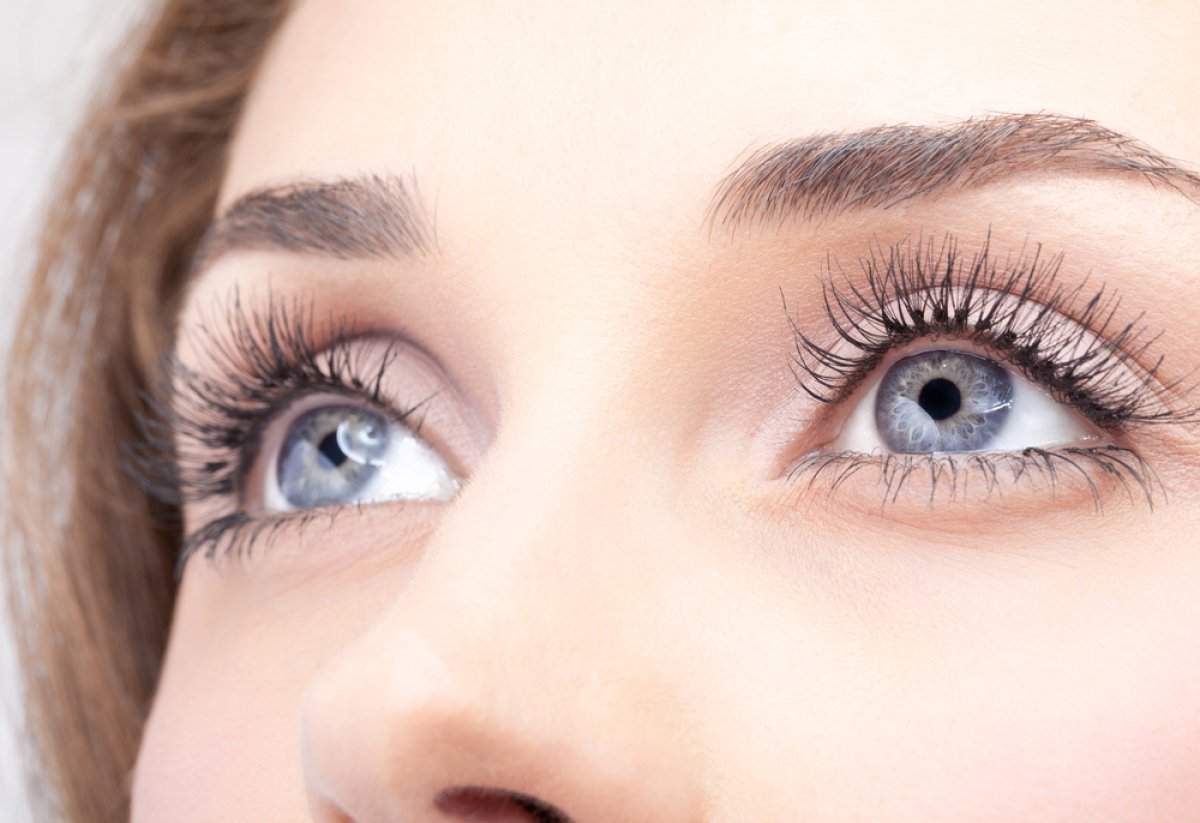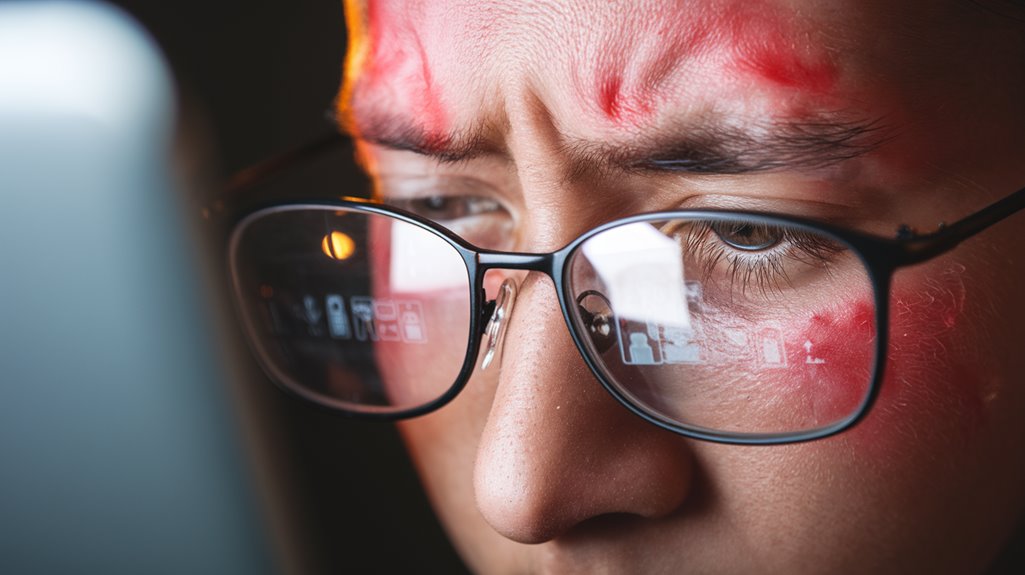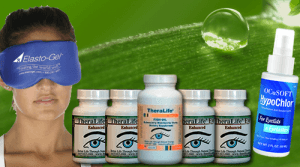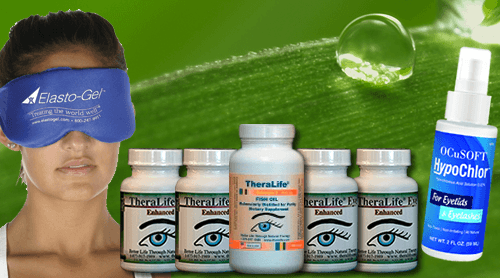Frequent use of digital devices can exacerbate blepharitis symptoms by decreasing blink rate and affecting eye hydration. Blue light from screens increases eye strain and fatigue, leading to tear film instability, especially with prolonged exposure. Poor posture during extended device use further worsens the condition. TheraLife’s products are designed to alleviate these symptoms, offering relief through natural and effective solutions. By following the 20-20-20 rule and maintaining proper hygiene, you can also help ease discomfort. Discover more ways TheraLife can enhance your eye health and mitigate the effects of digital device usage.
Best Blepharitis Treatment From TheraLife
Add To Cartrstanding and control of this persistent condition.
Key Takeaways
- Frequent screen use reduces blinking rates, decreasing eye hydration and worsening blepharitis symptoms.
- Prolonged screen time causes tear film instability, aggravating Meibomian Gland Dysfunction (MGD).
- Screen-related eye strain increases ocular discomfort, intensifying blepharitis symptoms.
- Poor posture during device use adds pressure on the ocular surface, exacerbating symptoms.
- Blue light from screens contributes to eye strain and fatigue, worsening blepharitis.
Understanding Blepharitis: Causes and Symptoms
When it comes to understanding blepharitis, it’s vital to grasp its root causes and symptoms. Blepharitis is an inflammatory condition affecting the eyelids. The causes overview includes bacterial infections, malfunctioning oil glands, and allergic reactions. These culprits lead to inflammation and discomfort, making symptom identification critical for effective management. You might notice symptoms like redness, irritation, and crusty deposits on the eyelids. Other signs include burning sensations, excessive tearing, and a gritty feeling in the eyes. It’s important to be vigilant, as these symptoms can fluctuate in severity. Recognizing these signs early helps in seeking appropriate treatment and preventing complications. Inflammatory cytokines such as IL-1beta, TNF-alpha play a significant role in the development of blepharitis, contributing to the inflammatory response and exacerbating symptoms.
The Role of Digital Devices in Eye Health
Understanding the causes and symptoms of blepharitis sets the stage for exploring how digital devices impact eye health.
Frequent use of screens can lead to reduced blink rates, which compromises eye hydration and exacerbates dryness. When you’re engaged with digital devices, you often forget to blink, causing a decrease in moisture on the ocular surface. Over time, this can strain your eyes and lead to discomfort or irritation.
To mitigate these effects, consider a digital detox. Reducing screen time allows your eyes to rest and recover, maintaining ideal hydration levels. Strategic breaks during digital use can prevent excessive dryness and preserve eye health. Prioritizing these practices helps safeguard against the potential adverse effects of prolonged exposure to screens, promoting overall ocular well-being.
In addition, incorporating omega-3 fatty acids into your diet can support eye health and help alleviate symptoms of dry eyes.
How Screen Time Aggravates Blepharitis
Prolonged screen time can greatly aggravate blepharitis, a common eyelid inflammation condition. When you’re glued to digital devices, you’re more likely to experience screen fatigue, which exacerbates blepharitis symptoms.
The main reason is a significant reduction in blinking frequency, leading to poor tear distribution and eyelid irritation.
Consider these critical factors:
- Reduced Blinking: Normal blinking frequency decreases by up to 66% during screen use, causing dry, irritated eyes.
- Increased Eye Strain: Constant focus on screens contributes to screen fatigue, intensifying blepharitis discomfort.
- Poor Posture: Extended device use often promotes awkward head positions, increasing pressure on the ocular surface.
In addition, tear film instability is exacerbated by prolonged screen use, making it a significant concern for individuals experiencing MGD and related conditions.
The Science Behind Digital Eye Strain
Although digital devices have revolutionized how we work and communicate, they also pose significant risks to ocular health, particularly through digital eye strain. This condition arises from prolonged screen exposure, causing symptoms like eye fatigue, dryness, and discomfort.
When you engage with screens, you tend to blink less frequently, reducing eye hydration. This diminishes the tear film, essential for keeping your eyes moist and comfortable. Additionally, the blue light emitted by screens can penetrate deep into the eye, contributing to strain and fatigue.
A digital detox can alleviate these effects by giving your eyes a break from continuous exposure. By understanding the science behind digital eye strain, you can better manage its impact and preserve your ocular health. For individuals with Meibomian Glands dysfunction, prolonged screen time can exacerbate symptoms by further reducing the secretion of the oily substance needed for lubrication.
Tips for Reducing Screen Time Impact on Blepharitis
To minimize the effects of screen time on blepharitis, adjust your screen brightness to match the ambient light, reducing eye strain. Implement the 20-20-20 rule by taking a break every 20 minutes to look at something 20 feet away for 20 seconds, helping to rest your eyes. Chronic dry eyes can exacerbate inflammation and discomfort, making it essential to manage screen time effectively. These strategies can alleviate digital eye strain and support better eye health.
Adjust Screen Brightness
When managing blepharitis, adjusting your screen brightness is essential in mitigating the adverse effects of screen time. Excessive brightness can strain your eyes, potentially exacerbating blepharitis symptoms.
To optimize your screen settings:
- Adjusting contrast: Enhance readability by balancing contrast. This reduces eye strain and makes text clearer.
- Blue light reduction: Implement blue light filters or settings to minimize harmful short-wavelength light that can aggravate your condition.
- Adaptive brightness: Enable features that automatically adjust brightness based on ambient light, easing eye fatigue.
- Eyelid hygiene is crucial for managing blepharitis symptoms, as supported by Mayo Clinic recommendations, which emphasize the importance of maintaining clean eyelids to prevent exacerbation of symptoms.
Implement 20-20-20 Rule
Many ophthalmologists recommend the 20-20-20 rule as an effective strategy to mitigate the impact of screen time on blepharitis. This simple, yet strategic approach offers the 20 20 20 advantage by encouraging you to take regular screen breaks. Every 20 minutes, you should shift your focus to an object 20 feet away for at least 20 seconds. This practice not only reduces digital eye strain but also promotes tear film stability, which is essential in managing blepharitis. Consistent eyelid hygiene can further enhance the positive effects of this routine by reducing bacterial overgrowth and maintaining overall eye health.
Eye Care Practices to Alleviate Symptoms
While facing the discomfort of blepharitis, implementing effective eye care practices can greatly alleviate symptoms. A consistent eyelid hygiene routine is essential.
Start by using natural remedies like warm compresses to soothe inflammation and unclog glands. Gently massage your eyelids to improve circulation and remove debris.
Here are some key practices to take into account:
- Maintain eyelid hygiene: Clean your eyelids daily with a gentle, non-irritating cleanser to reduce bacterial buildup.
- Use natural remedies: Warm compresses can help loosen oil and debris on your eyelid margins, providing relief.
- Stay hydrated: Drinking plenty of water keeps your eyes moist and reduces dryness.
- To effectively manage chronic blepharitis, incorporating a combination of treatments and maintaining proper eyelid hygiene is crucial, as recurring inflammation can persist despite ongoing care.
Best Blepharitis Treatment From TheraLife
Add To Cartrstanding and control of this persistent condition.
When to Seek Professional Help for Blepharitis
How do you know it’s time to seek professional help for blepharitis? If your symptoms persist despite home care, it’s vital to consult a healthcare professional. They can evaluate your condition and recommend treatment options. Persistent redness, swelling, or pain may require prescription medications or specialized therapies. Additionally, good hygiene practices are essential for managing blepharitis and can significantly reduce the frequency of flare-ups. Here’s when to seek help:
| Symptom Duration | Intensity | Treatment Options Needed |
|---|---|---|
| 1-2 weeks | Mild | Over-the-counter |
| 3-4 weeks | Moderate | Prescription medication |
| 4+ weeks | Severe | Advanced therapies |
Joining support groups can provide additional insights and shared experiences. These groups often discuss effective management strategies and new treatment options. If your condition affects vision or daily activities, professional evaluation is essential. Don’t wait for complications; seek guidance promptly.
Best Blepharitis Treatment From TheraLife
Add To Cartrstanding and control of this persistent condition.
Frequently Asked Questions
Can Blepharitis Be Hereditary?
Yes, blepharitis can have a genetic predisposition. If you have a family history of blepharitis, your chances of developing the condition may increase.
It’s important to understand that while genetics can play a role, they aren’t the sole determinant. Other factors like lifestyle and environment also contribute.
Monitoring symptoms and consulting with a healthcare professional can help you manage potential hereditary influences effectively.
Stay informed about your family’s medical history.
Are Certain Screen Colors More Irritating for Blepharitis?
Yes, certain screen colors can irritate blepharitis symptoms, especially if you’re light-sensitive.
Blue light, commonly emitted by screens, is particularly harsh and may exacerbate discomfort.
Opt for warmer colors, which tend to be gentler on your eyes.
Reducing brightness and using screen filters can also help manage irritation.
Adjusting these settings might alleviate some symptoms, allowing for more comfortable screen use without worsening your condition.
How Do Diet and Nutrition Affect Blepharitis?
Think of your diet as a secret weapon in your battle against blepharitis. Consuming anti-inflammatory foods like salmon and leafy greens can help reduce symptoms.
Staying hydrated is vital; water keeps your eyes moist and flushes out toxins. Omega-3 fatty acids, often found in fish oil, are particularly beneficial.
Can Blue Light Glasses Help With Blepharitis Symptoms?
You’re wondering if blue light glasses can help with blepharitis symptoms.
While they’re not a direct treatment for blepharitis, they can enhance eye comfort when you use digital devices.
Blue light glasses reduce exposure to high-energy visible light, potentially decreasing eye strain and fatigue.
Are There Any Non-Digital Treatments for Blepharitis?
Imagine your eyes as a garden that needs regular care. For blepharitis, you’ve got tools like warm compresses, acting like sunlight to soothe and open blocked glands.
Practice eyelid hygiene like a gardener tending to the soil, removing debris and ensuring a healthy environment. These non-digital treatments can greatly ease symptoms.
Regular attention can transform your eye health, nurturing relief and clarity just like a well-maintained garden flourishes.
Best Blepharitis Treatment From TheraLife
Add To Cartrstanding and control of this persistent condition.
Conclusion
In our digital age, excessive screen time can worsen blepharitis symptoms due to a significant reduction in blinking, leading to dryness and irritation. theralife.com offers a range of products designed to alleviate these symptoms and enhance eye health. By incorporating their solutions, users can experience relief from discomfort and maintain optimal eye function. Regular eye care practices, such as the 20-20-20 rule—looking at something 20 feet away for 20 seconds every 20 minutes—combined with theralife.com’s products, can significantly improve eye health. Additionally, seeking professional help if symptoms persist ensures comprehensive care. Theralife.com is committed to prioritizing your eye health by offering effective treatments tailored to your needs.





